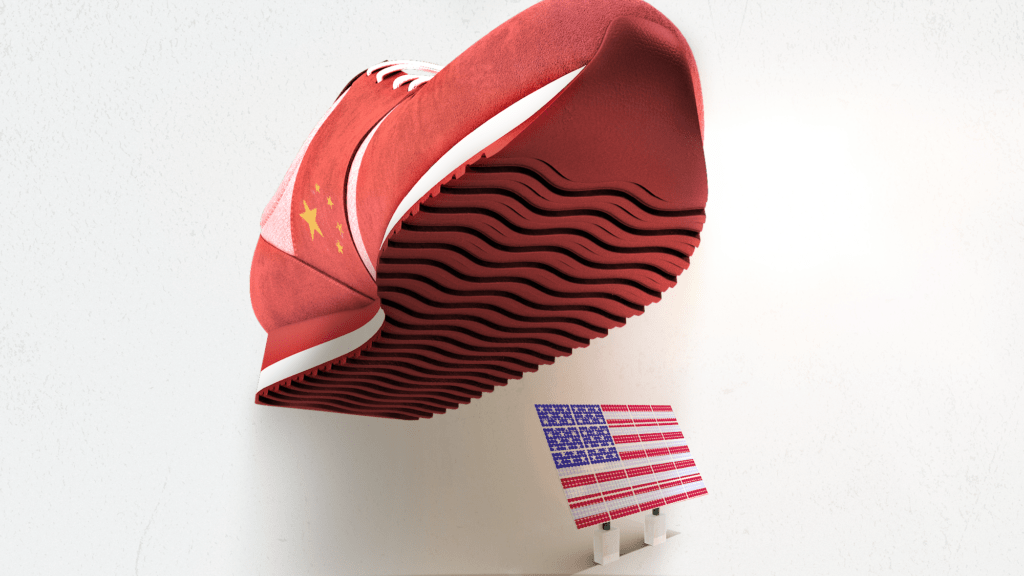Chinese solar manufacturers could take advantage of the Inflation Reduction Act’s tax credits by opening plants in the United States.
As campaign season approaches, Democrats in Congress and the Biden administration will surely tout the Inflation Reduction Act (IRA) as a major achievement. And thanks to generous tax credits, the 2022 law has spurred more than $10 billion in new domestic solar manufacturing plans. The White House reports that the IRA has already created more than 170,000 jobs, with 1.5 million additional jobs expected in the next decade. That sounds promising, but a new tidal wave of solar imports from China—combined with Biden administration decisions—could put it all in jeopardy.
Right now, the IRA’s tax credits are indeed helping to accelerate solar installations in the United States. According to analysts at Wood Mackenzie, the United States will add roughly 32 gigawatts (GW) of new solar capacity in 2023—a 52 percent increase from last year.
But how much of this will actually be made in America?
A careful look reveals that global manufacturing capacity and imports are rising much faster than U.S. production. In fact, U.S. Customs data show that solar module imports in the first seven months of 2023 were up 179 percent from the same period last year.
Most of these solar modules are coming from Vietnam, Cambodia, and Malaysia—the same countries that the U.S. Department of Commerce determined last year are being used by Chinese solar manufacturers to illegally circumvent U.S. duties. Despite this, President Biden issued a rule that allows China to continue this illegal transshipment until June 2024—and even vetoed bipartisan legislation to repeal it.
The raw materials and solar cells in these modules also come from China. Clean Energy Associates reports that China’s production capacity will double this year alone. By the end of 2023, China will account for 768 GW. That’s the overwhelming bulk of a projected 866 GW in total global production capacity.
By next year, China will be producing close to 1,000 GW annually of solar capacity. This is more than double China’s capacity just one year ago—when the IRA was passed.
Beijing has long aimed to be the dominant global power in renewable energy. And thanks to massive subsidies, cheap loans, and subsidized electricity, China’s solar industry is now expanding at a phenomenal rate—with eight of the world’s ten largest solar panel manufacturers based in China.
This massive overproduction is creating an excessive global supply of solar panels, leading to rapid price-cutting. According to industry sources, utilities currently pay roughly 35 cents a watt for solar panels. However, they’re already placing orders for next year at price points falling to 25 cents/watt.
The 25 cents/watt figure was roughly half the price of solar panels when Congress passed the IRA in August 2022. But back then, the bill’s tax credit of seven cents/watt was considered generous. Now, the tax credit isn’t enough to meet falling prices. U.S. manufacturers simply can’t stay in business at 25 cents per watt.
Since the IRA passed, U.S. solar manufacturers—led by First Solar, Heliene, Silfab, Qcells, and Auxin Solar—have announced manufacturing expansion plans, including factories across America totaling some 85 GW of new capacity. But a price-driven market crash could put their viability at risk.
Chinese solar manufacturers could also take advantage of the IRA’s tax credits by opening plants in the United States. In the past few weeks, three major Chinese solar producers—Trina Solar, Canadian Solar, and Longi—have announced plans to build U.S. panel assembly facilities—each with a capacity of 5 GW. As a result, Chinese producers could eventually claim as much as $125 billion in federal tax credits under the IRA.
The IRA was intended to boost domestic U.S. solar manufacturing. But China’s new solar flood clearly threatens this. If Congress and the Biden administration want the IRA to be successful—and reduce China’s dominance in the solar industry—lawmakers must pass additional legislation to ban China from receiving IRA tax credits. Failing to do so threatens the IRA’s success and the carefully laid plans of multiple American solar manufacturers hoping to increase domestic manufacturing in the United States.












